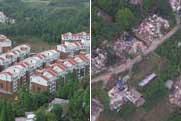World
Backgrounder: Space debris -- man-made threat in space exploration
The average speed of space debris is 10 km per second and the maximum speed can be 16 km per second. Explosion or disassembly could happen if the craft is hit by a large piece of space debris.
Even a 10-gram piece of debris can generate a collision force in space equaling to the crash of a car running at 100 km per hour, Du Heng, chief scientist with China's space debris action program, has said.
Therefore, scientists attending last April's conference have called on the international community for joint efforts to reduce spaces debris.
The threat is debris would begin slamming into other debris, creating a cascading effect called "super-criticality," they said.
According to the scientists, a satellite orbiting Earth passes within 60 miles (about 96.6 km) of a piece of junk several thousand times a day and has a one percent chance each year of getting hit.
On the other hand, "we are in danger of a runaway escalation of space debris," MIT physicist Geoffrey Forden said at the conference.
But So far no effective way to collect space rubbish or avoid them from collision has been worked out. Satellite and spacecraft launchers can only try producing as less debris as possible while monitoring large debris and improving solidity of space vessels.
According to Du, less debris is nowadays produced by the explosion of abandoned rockets with surplus fuel.
Improvement in spacecraft has also been made, including strengthening solidity and designing special protection areas. The measures on the International Space Station seem effective in resisting the collision with small debris. Space powers are also trying to enhance monitoring abilities, wanting to lower the size of traceable debris to one cm.
However, to avoid approaching large debris is the best way.
Editor:Zhang Pengfei



